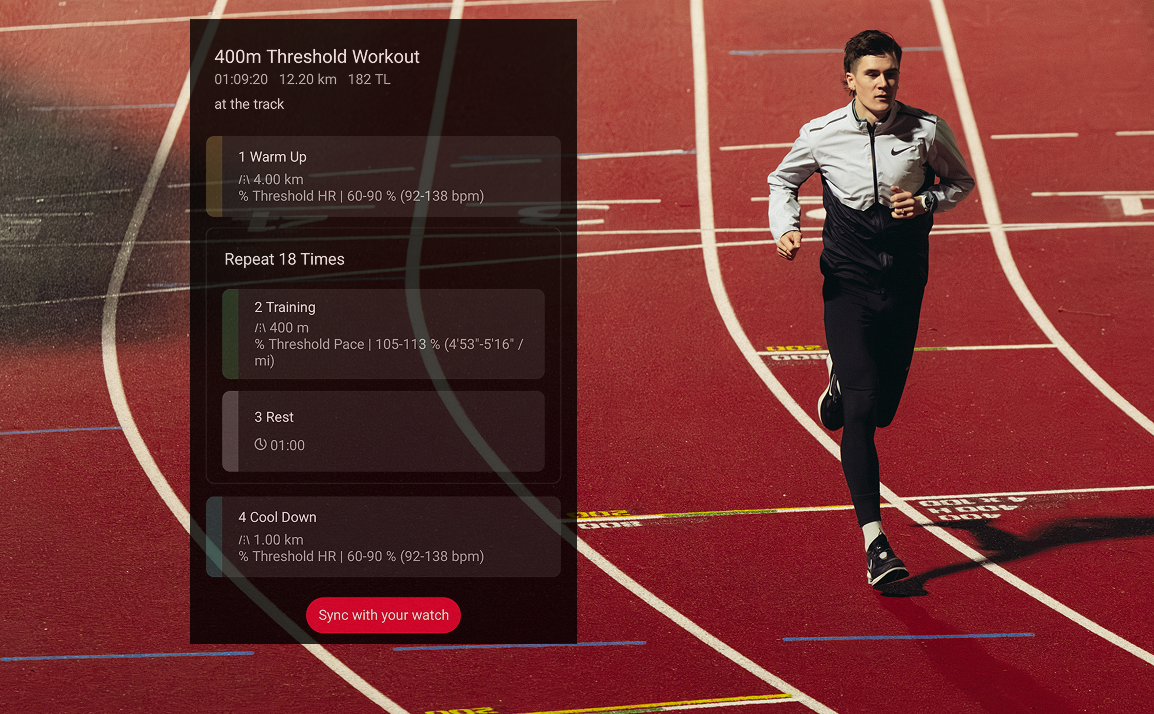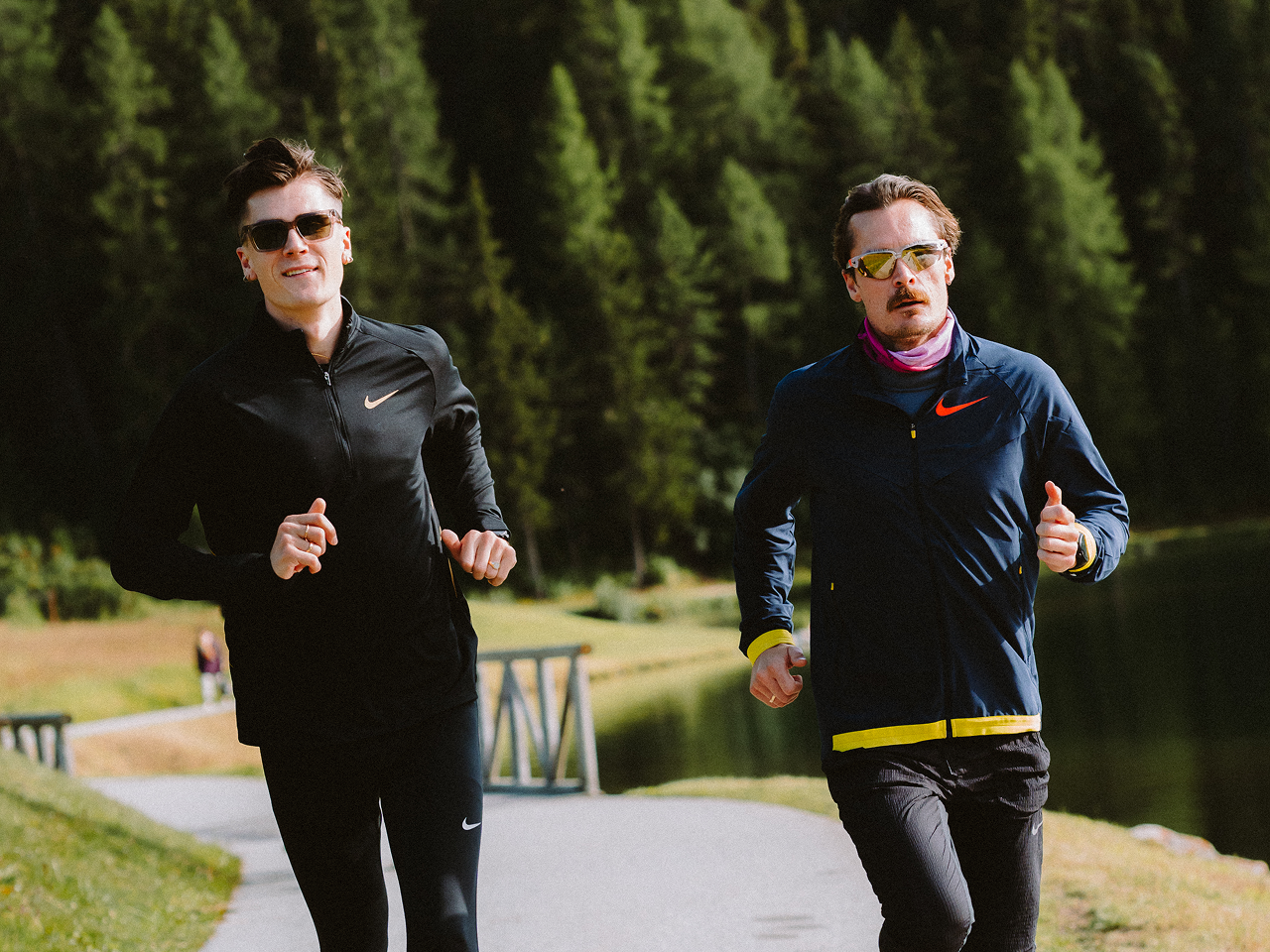In recent years, “threshold training” has dominated running conversations, and for good reason. Though the concept dates to the 1980s, today’s science and a cascade of world-class PRs confirm it as the smartest path to sustainable speed.
Threshold workouts live in the sweet spot of endurance training: hard enough to lift your aerobic ceiling, yet controlled enough to accumulate volume without torching your nervous system. Below, we unpack the design principles, rest protocols, real-world examples (including Jakob Ingebrigtsen’s famous double-threshold days), and common mistakes to avoid on your first session.
How Are Threshold Workouts Designed?
Threshold workouts target Zone 4 intensity. The primary goal is to accumulate time at this pace. Short rest intervals help break the workout into manageable sets while keeping the overall effort in check.
For upper-level athletes with a big aerobic base, aim for 30 minutes of total work at threshold pace. If your athletes are young or still developing, have them do 20–25 minutes at a slightly slower pace.
Sample Threshold Workouts (By Level)
Click any of the workouts below to download them to your Training Calendar!
- 7 × 3 min @ Zone 4 (1 min jog)
- 5 × 1 mile @ Zone 4 (2:30 jog)
- 4 × 2 km @ Zone 4 (3 min jog)
- 4 × 6 min @ Zone 4 (2 min jog)
- 18 × 400 m @ Zone 4 (1 min standing)
*Used by Jakob Ingebrigtsen on his Double-Threshold Days

Common Mistakes
As a college coach watching threshold workouts weekly, the main mistake we always see is athletes running too hard. Threshold should be at a pace that is fast, but manageable enough that you can run 25–30 minutes of these reps and still feel good afterward. If you see an athlete huffing and puffing at any point in the workout, they are going too fast and should slow down or cut the session short.
When an athlete is new to threshold training, they may not understand what's so great about going slower with shorter rest. Athletes love “ripping” and having hands-on-knees at the end of a session. That is not the goal with this zone.
The COROS Running Fitness Test helps you find your unique pace, and you can confirm it in each workout using the 'talk test':
- If you can’t speak at all, you are going too hard
- If you can say multiple clear sentences, you are going too slow
- If you're able to say 3-4 words at a time, you're probably in the right zone
The gold standard for nailing your true threshold is lab-based lactate testing, but for most runners that’s out of reach. COROS delivers the next-best solution: as you train and race wearing it, the algorithm automatically refines your threshold using real performance data. Start with an estimated 5:30 pace, crush a 5K a few weeks later, and EvoLab quietly adjusts you to a more accurate 5:20. Your zones simply evolve with your fitness, no expensive field tests required.
The next mistake is training at someone else's threshold pace. Group sessions often cause some athletes to go too slow and others too fast. This type of training is highly individualized, so training in large groups inevitably leads to someone going the wrong pace.
What about athletes with similar race times? Although two athletes might produce the same PR, their skillsets might differ. One may have a strong anaerobic system with more fast-twitch fibers, while the other is long-distance oriented with slow-twitch fibers. That means the fast-twitch runner could struggle at a pace the slow-twitch runner can hold longer.
Here are a few tips to keep these training sessions at threshold and avoid overworking your athlete:
- Wind (don’t fight it): When the wind is howling (and in western Kansas where I coach, anything under 15 mph barely counts as a breeze), chasing a specific pace is a trap. A 30 mph gust can turn a simple threshold session into an accidental VO₂ max beatdown, especially on the track where athletes stubbornly try to hit splits while fighting the wind. We’re proud of our blue-collar, tough-it-out reputation out here on the plains, but smart training still wins. On windy days we ease the target paces, adjust the course so athletes can surge with the tailwind and recover into the headwind, or simply cut the pace goals altogether and run by effort.
- Surface: Run on flat ground, and avoid hills that spike effort. Also, note how responsive the surface is. Grass and dirt are great, but may run a few seconds per mile slower than pavement.
- Treadmill: Many great runners do threshold work on the treadmill. It’s a great tool to stay in the desired zone and control climate.

How to Determine Rest Between Reps
Short rest is the callsign of a Threshold workout, but what constitutes as 'short' will depend on the length of the rep.
| Rep Length | Rest (Jog) | Who Uses It |
| 3–5 min | 1–2 min | Beginners |
| 6–10 min | 2–3 min | Intermediate |
| 12+ min | 3–4 min | Advanced |
Elite Examples:
- Jack Daniels: 25–33% of rep time (8 min rep → 2–2.5 min jog)
- Team Ingebrigtsen: 45–60 sec
- Renato Canova: 3 min jog after 15-min blocks
Field Check: After a rep, HR should drop below 70% max before starting the next. If not, add 30 sec.
Final Thoughts: Stack the Days
Threshold training doesn't look flashy on Strava, instead it's focus is on stacking controlled efforts, day after day, until extreme fitness emerges. John L. Parker captured this truth decades ago in Once a Runner:
“You don't become a runner by winning a morning workout. The only true way is to marshal the ferocity of your ambition over the course of many days, weeks, months, and (if you could finally come to accept it) years. The Trial of Miles; Miles of Trials.”
Next up, it's your move:
- Find your threshold pace (Running Fitness Test)
- Pick one workout above
- Do it weekly for 6 weeks
- Watch your easy pace drop and race times fall

/filters:quality(90)/fit-in/970x750/coros-web-faq/upload/images/1a896037e041c7c4d34a82c693e00d35.png)




